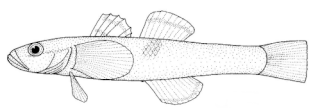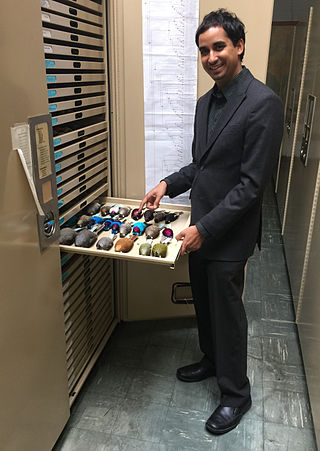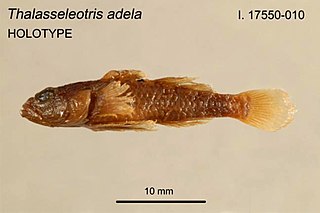
Eleotridae is a family of fish commonly known as sleeper gobies, with about 34 genera and 180 species. Most species are found in the tropical Indo-Pacific region, but there are also species in subtropical and temperate regions, warmer parts of the Americas and near the Atlantic coast in Africa. While many eleotrids pass through a planktonic stage in the sea and some spend their entire lives in the sea; as adults, the majority live in freshwater streams and brackish water. One of its genera, Caecieleotris, is troglobitic. They are especially important as predators in the freshwater stream ecosystems on oceanic islands such as New Zealand and Hawaii that otherwise lack the predatory fish families typical of nearby continents, such as catfish. Anatomically, they are similar to the gobies (Gobiidae), though unlike the majority of gobies, they do not have a pelvic sucker.

Graham's gudgeon, Grahamichthys radiata, is a species of goby of the family Thalasseleotrididae, the only member of the genus Grahamichthys. This species is found in rock pools and in the neritic zone, to 50 metres (160 ft) in depth, where sand or mud is lies around and partially buries rocks, shells, or other objects. It is unusual for a goby, in that it lives in loose schools.
The Mitchell gudgeon is a species of fish in the family Eleotridae endemic to the Kimberley region of Australia, where it is only known from the Mitchell River system. This species can reach a length of 4 cm (1.6 in). The specific name honours the ichthyologist J. Barry Hutchins of the Western Australian Museum, who collected the type.
Milyeringa veritas is a species of fish in the family Milyeringidae. It is endemic to groundwater and anchialine systems in caves in the Cape Range, Australia. Like other cave-adapted fish, the blind gudgeon is entirely blind and lacks pigmentation, using sensory papillae on its head and body to move around and find food. It has a reduced number of scales on its body and the head is almost scaleless. It reaches a standard length of 5 cm (2.0 in). It is listed as vulnerable under the Australian Environment Protection and Biodiversity Conservation Act 1999. It is an omnivorous species which feeds on algae and possibly also detritus, as well as invertebrates. Invertebrates consumed by M. veritas include Stygiocaris sp., aquatic insect larvae such as those of caddis flies and non aquatic invertebrates which accidentally fall into the water such as isopods, ants and cockroaches. When the gut contents have been sampled 10% of the identifiable gut contents were Stygiocaris and 70% were terrestrial species, despite this species being restricted to caves. They are often observed hanging still in the water column or resting on ledges in the cave walls, behaviours which they also display when kept in aquaria, but can move quickly to avoid capture if threatened, for example when catching them with a net is attempted. The generic name is taken from Milyering which is 20 miles (32 km) southwest of Vlamingh Head in the North West Cape of Western Australia, the type locality, and the specific name is Latin veritas meaning truth an allusion to a quote attributed to the Ancient Greek philosopher Democritus "Truth lies at the bottom of a well, the depth of which, alas! gives but little hope of release.”

The blind cave eel is a species of cavefish in the family Synbranchidae. It is the longest cavefish in Australia and one of the only three vertebrates in Australia that is restricted to underground waters, the other being the blind gudgeon and the Barrow cave gudgeon. It is blind, its body is eel-like and elongated, and it has a non-pigmented skin with colours ranging from white to pink.

Typhleotris is a genus of cavefish that are endemic to caves in southwestern Madagascar. Although traditionally considered to belong to the family Eleotridae, studies show that they represent a distinct and far-separated lineage together with the Milyeringa cavefish from Australia, leading some to move them to their own family, Milyeringidae.
Typhleotris pauliani is a critically endangered species of fish in the family Milyeringidae that is endemic to Madagascar, where it is only known from a few caves and sinkholes in the southwestern portion of the island. This blind cavefish lacks pigmentation and can reach a standard length of 7.1 cm (2.8 in). It feeds on invertebrates and guano. Part of its range receive some protection, but the species is threatened by disturbance from recreational activities and collectors of guano. The specific name honours the French entomologist and former deputy director of the Institut de recherche pour le développement in Madagascar, Renaud Paulian (1913-2003), who collected the type specimens as well as contributing a lot to the knowledge of the biogeography of the western Indian Ocean.

The Gobiiformes are an order of fish that includes the gobies and their relatives. The order, which was previously considered a suborder of Perciformes, is made up of about 2,211 species that are divided between seven families. Phylogenetic relationships of the Gobiiformes have been elucidated using molecular data. Gobiiforms are primarily small species that live in marine water, but roughly 10% of these species inhabit fresh water. This order is composed chiefly of benthic or burrowing species; like many other benthic fishes, most gobiiforms do not have a gas bladder or any other means of controlling their buoyancy in water, so they must spend most of their time on or near the bottom. Gobiiformes means "goby-like".

Cavefish or cave fish is a generic term for fresh and brackish water fish adapted to life in caves and other underground habitats. Related terms are subterranean fish, troglomorphic fish, troglobitic fish, stygobitic fish, phreatic fish, and hypogean fish.
Genetypes is a taxonomic concept proposed in 2010 to describe any genetic sequences from type specimens. This nomenclature integrates molecular systematics and terms used in biological taxonomy. This nomenclature is designed to label, or flag, genetic sequences that were sampled from type specimens. The nomenclature of genetypes proposes that genetic sequences from a holotype should be referred to as a “hologenetype”, sequences from a topotype should be a “topogenetype”, and so forth. In addition, the genetic marker(s) used should be incorporated into the nomenclature.
Typhleotris mararybe is a critically endangered species of fish in the family Milyeringidae, the blind cave gobies. It is a troglobitic species endemic to cave habitat in southwestern Madagascar. It is unique among known cave-dwelling fish in that is both blind and darkly pigmented. It has well-developed nonvisual sensory systems and dives to avoid approaching objects. The fish was first collected in 2008 and was described to science as a new species in 2012.
Milyeringa justitia, commonly known as the Barrow cave gudgeon, is a species of fish in the family Milyeringidae endemic to groundwater systems (aquifers) of Barrow Island, around 50 km off the Pilbara coast in Western Australia. This troglobitic species has a pale body, lacking in pigment, and it is eyeless and blind, using sensory papillae located on the head and body to allow it to feed and move around in total darkness. The specific name justitia is Latin for "justice" and was given by the describers to complement the specific name of Milyeringa veritas which means "truth" in the hope that “As truth and justice are supposed to go together, we name this species justitia, from the Latin for justice, in the hope that justice helps the species to survive on Barrow Island, which has been an oilfield since 1967 and is most recently the site of the Gorgon Gas Hub development.” Very little is known about M. justitia as between 2002 and 2013 only six specimens were collected but its biology is assumed to be similar to that of M. veritas.
Caecieleotris morrisi, also known as the Oaxaca cave sleeper is a species of troglobitic fish in the family Eleotridae found in a single cave system beneath Presa Miguel Alemán reservoir, northern State of Oaxaca in Mexico. This species is the only member of its genus.

Milyeringidae, the blind cave gobies, is a small family of gobies, in the order Gobiiformes. There are two genera and six species within the family, which is considered to be a subfamily of the Eleotridae by some authorities. Milyeringidae includes one genus (Milyeringa) restricted to caves in the North West Cape region of Australia and the other (Typhleotris) to underground water systems in Madagascar. They are all troglobitic species and have lost their eyes.

Prosanta Chakrabarty is an American ichthyologist and George H. Lowery Jr. Professor of ichthyology, evolution and systematics at Louisiana State University. He studied at McGill University where he received a bachelor of science in Applied Zoology and at the University of Michigan where he obtained his PhD in Ecology and Evolution. Among other professional positions he was a Program Director for the National Science Foundation and was the President of the American Society of Ichthyologist and Herpetologist in 2023. He was named a TED Fellow in 2016, and a TED Senior Fellow in 2018. He was named an Elected Fellow of the AAAS for "distinguished contributions to evolutionary biology, focusing on the bioluminescent systems and historical biogeography of freshwater fishes, and for effectively communicating science to the public".
Belobranchus segura is a species of eleotrid sleeper goby which has been found in Indonesia on Halmahera, in Papua Barat and also on the Solomon Islands. It is an anadromous species in which the eggs are laid over rocky and gravel bottoms in freshwater streams. The free-swimming larvae then drift downstream to the sea where they undergo a planktonic stage before migrating up streams to mature and breed. It feeds on small crustaceans and fish. The specific name honours the French hydrobiologist Gilles Segura for his contribution to the study of fish faunas.

Thalasseleotris is a genus of gobies comprising two species in the family Thalasseleotrididae from the south-western Pacific Ocean in the seas off Australia and New Zealand. The generic name is derived from the Greek Thalassa meaning "sea" and the generic name Eleotris as at the time it was named the genus was considered to be in the family Eleotridae.
Oxyurichthys takagi is a species of goby is found in the Western Pacific: known only from Palau. This species reaches a length of 6.4 cm (2.5 in).

Wirz's goby is a species of goby found in Oceania from Papua New Guinea and northern Australia.

Oxuderces dentatus, is a species of goby found in the Indo-West Pacific from India to Vietnam, Macau, China, Malaysia and Indonesia.









